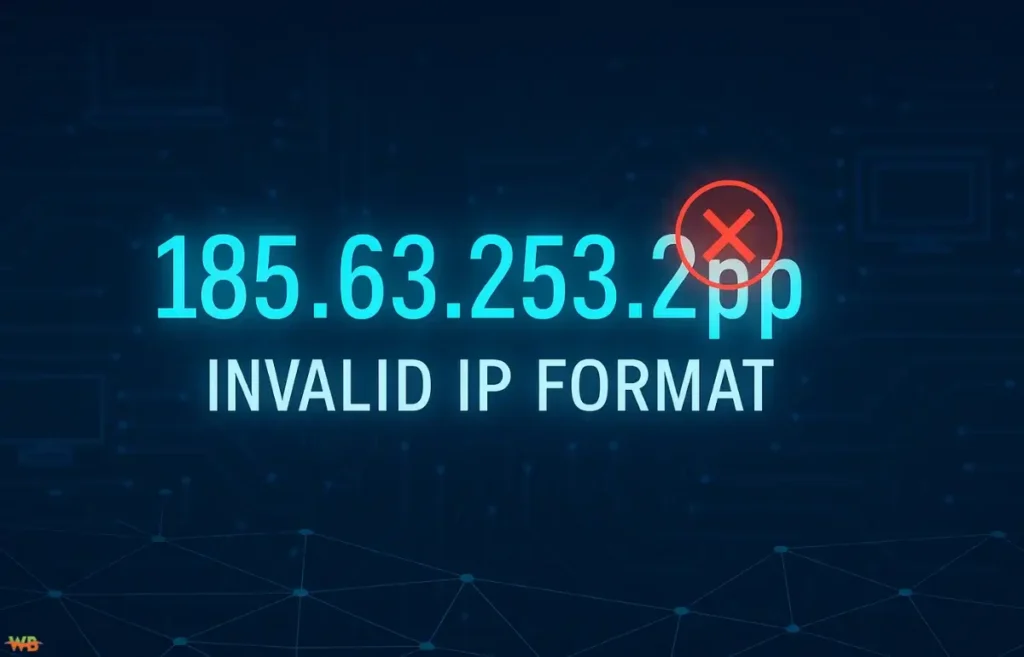In the digital age, precision matters—especially when dealing with network configurations. If you have ever stumbled upon 185.63.253.2pp and wondered whether it is a legitimate IP address, you are not alone. At first glance, it may seem like a standard IPv4 address, but the addition of “pp” makes it invalid. This article explores the reasons behind its invalidity, breaks down what makes an IP address valid, and walks you through how to verify and troubleshoot your own IP addresses.
What Makes 185.63.253.2pp Invalid?
The structure of an IPv4 address is quite strict. A valid IPv4 format includes four decimal numbers, with each segment separated by a period and limited to values from 0 to 255. So when you see 185.63.253.2pp, the non-numeric characters “pp” instantly disqualify it from being valid.
Whether you are configuring a server, troubleshooting a network issue, or setting up a smart device, using an incorrect address like 185.63.253.2pp can lead to unnecessary headaches.
185.63.253.2pp: What Leads to This Invalid Format?
Understanding how such an error arises is crucial for network administrators, developers, and even tech-savvy home users. Identify the frequent mistakes that produce malformed IP addresses.
1. Typographical Errors
In many cases, 185.63.253.2pp might simply be the result of a typo. Perhaps the last segment was meant to be a two-digit number, and someone accidentally typed “pp.”
2. Placeholder Addresses
When writing documentation or testing software, developers sometimes use fake IP addresses to avoid conflicts with real networks. The inclusion of letters like “pp” helps ensure the placeholder address is never accidentally used.
3. Data Corruption
During transmission, especially in poorly configured systems or corrupted files, parts of IP addresses can become distorted. This could transform a valid string into something like 185.63.253.2pp.
4. Script or Software Bugs
Applications that auto-generate or modify IP addresses might contain bugs that accidentally append characters. It is advisable to audit the program that generates the IP data if 185.63.253.2pp is being produced.
5. Obfuscation
On rare occasions, people deliberately mask real IP addresses with invalid characters to prevent bots from scraping sensitive data.
Basics of IPv4 Addressing: The Foundation You Need
To fully understand why 185.63.253.2pp is not valid, it helps to know how IPv4 addressing works.
Format and Structure
IPv4 addresses consist of four 8-bit numbers—each ranging from 0 to 255—written in dotted decimal form. For example:
-
Valid:
192.168.0.1,10.0.0.5,172.16.254.3 -
Invalid:
300.400.500.600,192.168.1,185.63.253.2pp
Each segment, or octet, must be a number. Letters or other symbols break the format.
Public vs. Private IPs
-
Private IP Ranges:
-
10.0.0.0 to 10.255.255.255
-
172.16.0.0 to 172.31.255.255
-
192.168.0.0 to 192.168.255.255
-
-
Internet-based communication relies on public IPs for routing data. A valid IP like
185.63.253.2(without the “pp”) could be public if not reserved or blacklisted.
So, 185.63.253.2pp is invalid not only because of its format but also because such a structure simply does not conform to how network layers process data.
How to Validate IP Addresses the Right Way
Whether you’re troubleshooting or just double-checking, knowing how to confirm an IP address is valid can save a lot of time. Let’s go over methods you can use immediately.
Visual Checks
Start by reading the IP address. Does it:
-
Contain exactly four parts separated by dots?
-
Have only numbers in each part?
-
Keep each number between 0 and 255?
If not, like in the case of 185.63.253.2pp, you are dealing with a malformed address.
Online IP Validators
There are free tools that check if an IP address is valid. Just enter the address, and they will confirm whether it follows proper syntax.
Try searching for “IP address validator” and use any trusted tool from sites like:
-
WhatIsMyIP.com
-
IPVoid.com
-
DNS Checker
These tools also reveal whether an address is public or private, and sometimes even show geographic locations tied to public IPs.
Use of Command-Line Tools
You can rely on pre-installed utilities within your OS to test the address.
Windows or Linux:
You’ll likely receive an error like “Ping request could not find host,” confirming the address is not usable.
Other Useful Commands:
-
nslookup 185.63.253.2pp(resolves domain names to IPs) -
tracertortracerouteto analyze route paths
Note: These won’t work for invalid addresses like 185.63.253.2pp, but they are valuable tools once you correct the IP.
Importance of Using Valid IP Addresses
Incorrect addresses like 185.63.253.2pp can disrupt network communication, lead to configuration errors, and even compromise network security.
When IP settings are misconfigured:
-
Devices fail to connect to the internet.
-
Local network services break down.
-
Security systems might block communications.
For organizations, improper IP configurations can result in downtime, reduced productivity, and increased technical support costs.
Best Practices to Avoid Mistakes Like 185.63.253.2pp
Preventing invalid entries like 185.63.253.2pp starts with adopting smart, consistent practices.
Automate Where Possible
Use DHCP to assign IPs automatically. It lowers the risk of input errors and keeps the structure consistent.
Double-Check Manual Entries
When static IPs are necessary, review your entries carefully. Keep a checklist or template to avoid issues.
Log and Audit Configurations
Periodically audit your network setup. Identify unusual entries or rogue addresses.
Educate Team Members
Even a basic understanding of IP formatting among your team can dramatically reduce common mistakes like entering 185.63.253.2pp.
Final Thoughts: Know the Rules Before You Type
At first glance, 185.63.253.2pp might seem like a harmless string, but in the world of networking, precision matters. One small error can have cascading effects.
By understanding the rules of IPv4, the tools available to check validity, and the most common pitfalls, you can confidently manage and troubleshoot IP configurations.
Keep your IP entries clean, numeric, and within range, because that is the foundation of a secure and functional network.
Learn about سایت bestfarsi

Ton Roobprom is an experienced writer focused on practical advice across technology, business, travel, beauty, lifestyle, and home improvements. He specializes in distilling complex subjects into clear, actionable insights to help you enhance your daily life.


